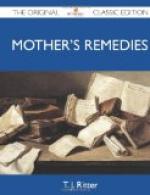Later Wear of the Wedding Gown.—The wedding gown is worn at the more formal of the post-nuptial entertainments. The trousseau should include an evening dress and wrap. For the former, black lace, chiffon cloth or net will prove the most serviceable, and almost universally becoming. A traveling gown, a handsome suit for visiting, receptions, etc., a pretty gown for receiving at home, and several house gowns will be needed. Kimonas, bath-robes, dressing-jackets, are included in the less ornamental parts of the trousseau.
A girl often invites her intimate friends to inspect her wedding finery, rejoicing in their admiration. The privilege of such a view is highly valued.
[736 Mothers’ remedies]
Bridal Flowers.—Orange flowers are reserved for the bride, and she never wears any other in her hair, at least no other that are artificial. She may carry any flowers, she prefers; the florists make all seasons alike. Often an order is given months in advance for the bride’s favorite flower to grace her wedding, and the florist forces it to bloom at the appointed time. White roses and carnations can be had at almost any season; sweet peas, white lilacs, lilies of the valley, are less easy to procure. The “shower bouquet” has many narrow white satin ribbons falling from it to the foot of the skirt, and knotted at intervals round flower sprays.
The rarest of bridal flowers are the orchids, so costly that only the rich may have them, though a few orchids, two or three, are sometimes put with lilies of the valley, or Roman hyacinths, intermixed with stephanotis or stevia, for the bridal bouquet. Bridesmaids may carry large clusters of flowers tied with ribbons, the flowers suiting their costumes. Or, if they all wear white, American Beauties may be chosen. The usual preference is for flowers in more delicate hues.
The Widow’s Bridal Attire.—A widow does not wear white at her second wedding, nor a veil, nor does she have bridesmaids. Her usual choice is to be married in a handsome traveling gown of some light color, wearing hat and gloves to match. The material may be silk or broadcloth for a church wedding. She wears her wedding ring up to the day of her second marriage. Though she may have no bridesmaids she may have a matron-of-honor, some married friend, who wears a street or reception dress, with suitable hat and gloves.
A woman who has entered her fourth decade does not, as a rule, wear white when married.
It is no longer customary for a woman to go into semi-retirement preceding her marriage. She does not parade herself; no lady would do that, but she accepts invitations and appears at all the fetes planned for her up to the wedding day. As a result, she is often very tired and fagged before the event.
The Man’s Wedding Garments.—One of the most frequent inquiries made of the editors of women’s departments in magazines relates to the proper attire for the bridegroom. “When is it correct to wear a dress suit?” and “What should the bridegroom wear at a day wedding?”




